#monogatari render
Text
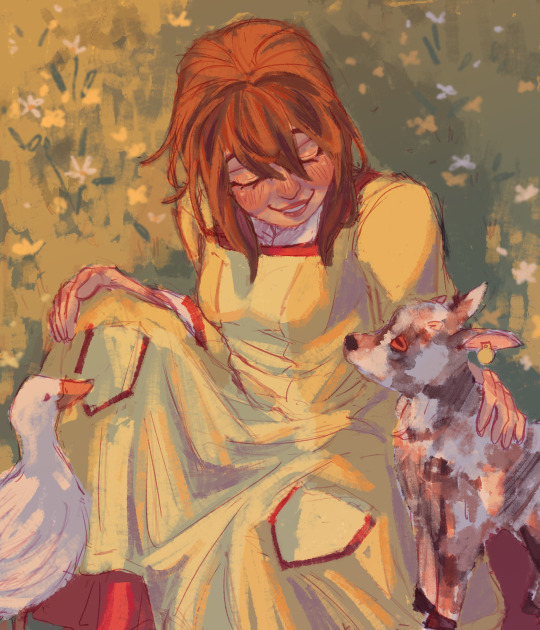
tbh i just realized i never posted this….still mad that i lost my old animal parade save data but drawing renee with a duck and baby goat sure does help ease the pain a little bit
#harvest moon#harvest moon animal parade#hm ap#harvest moon ap#story of seasons#bokumono#bokujou monogatari#animal parade#renee hmap#renee harvest moon#牧場物語わくわくアニマルマーチ#牧場物語#renee hm#pansy-art#you can probably tell i put way too much detail into the face rendering and just never finished tje rest
339 notes
·
View notes
Text
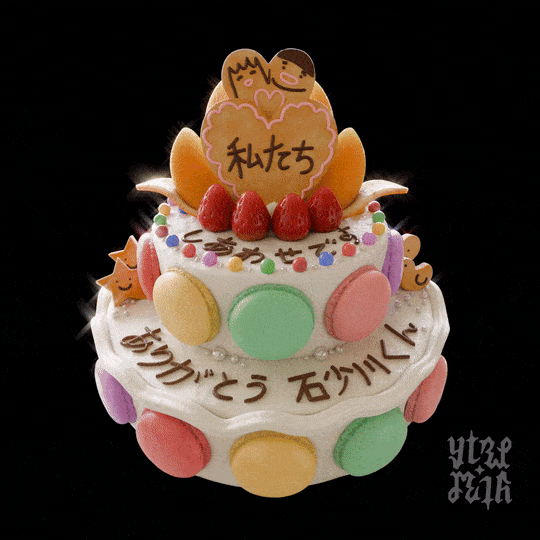
🎂 The "thank you sunakawa" cake from Ore Monogatari in 3D >:3
#ytremia#ore monogatari#blender3d#blender#b3d#3d model#3d modeling#3d art#anime food#artists on tumblr#digital art#3d render#3d
28 notes
·
View notes
Note
I need Schezo with irrational phobia to mirrors due to his past trauma of being sucked into the mirror and having to basically fight or die in the mirror world. He breaks every mirrors he sees but feels really bad afterwards every time due his emotional weakness.



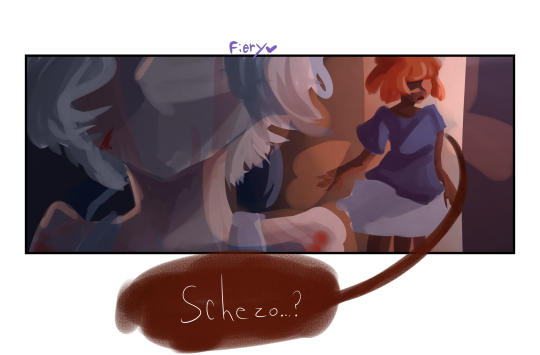
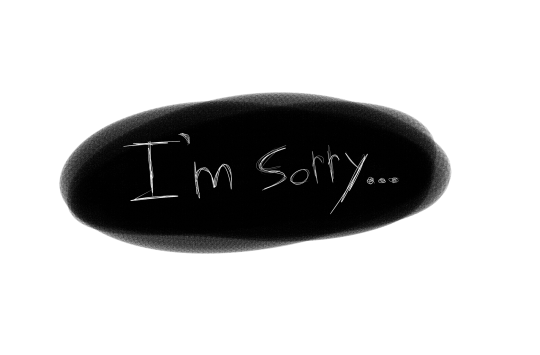
anon you are literally so right
#questions with fiery#cw blood#tw blood#blood#schezo puyo puyo#schezo wegey#arle nadja#arle puyo puyo#ARLES JUST CHECKING UP ON HIM OK DONT MAKE IT WEIRD#anyway anon you ignited a fire within me I want to write this shit IMMEDIATELY (if youre ok w it )#this was VERY VERY quickly rendered bc I wanted it visualized NOW#drawing with fiery#puyo puyo#madou monogatari
23 notes
·
View notes
Text
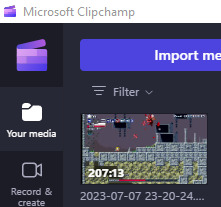
Bouta test the limits of Microsoft Clipchamp
(This is a full run from Depth 1 to Depth 20)
#doukutsu monogatari#doukutsu randamu#cave story#Heres hoping it's quicker at rendering videos than Blender#video editing
5 notes
·
View notes
Photo

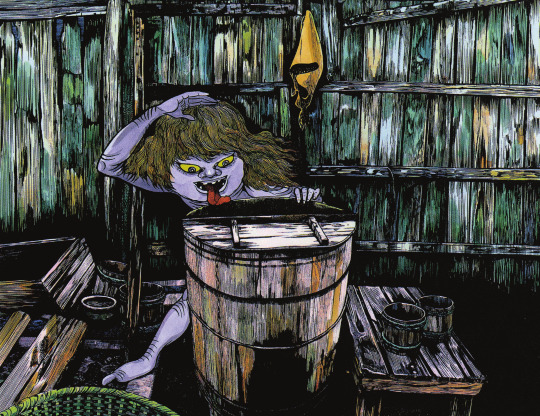



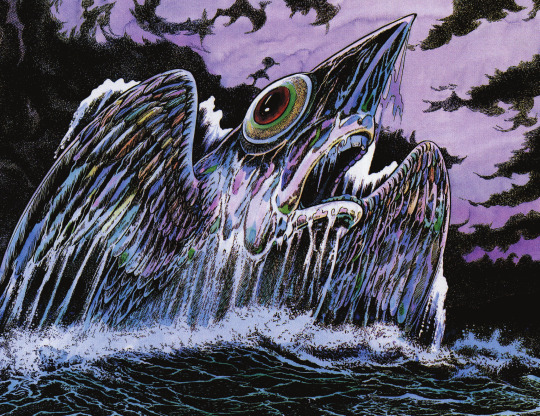




Yokai: The Art of Shigeru Mizuki. Published 10/31/2023 by Drawn & Quarterly.
Shigeru Mizuki is no stranger to the supernatural and its portents. Kitaro and Tono Monogatari reimagined the obscure folktales of his youth, bringing them to life with whimsy. Mizuki the cartoonist certainly left an indelible mark on comics as world literature. Mizuki the fine artist, on the other hand, rounds out the full scope of his fascination with the otherworldly and fantastic, bringing these worlds to life in robust color.
Yokai: The Art of Shigeru Mizuki showcases his expertise of not only folklore, but celebrates him as a naturalist. Elements of Mizuki’s lush compositions—flora, fauna, and everything in between—showcase his mastery of form and love for nature. These popular renderings of a disappearing, rural Japan are his contribution to the preservation of a cultural heritage that would have otherwise been forgotten. The grotesque realism central to his body of work is offset by the ingenuity of his fancy for the macabre. Pieces in this deluxe, full-color edition call to mind the playful pop-sensibility of Maurice Sendak informed by the technical prowess of traditionalists like Dürer and Doré. And like any other Mizuki classic, each oeuvre is a unique snapshot of spirit, human or otherwise, in constant transition.
Yokai: The Art of Shigeru Mizuki includes supplementary writing by acclaimed Mizuki scholar and translator Zack Davisson.

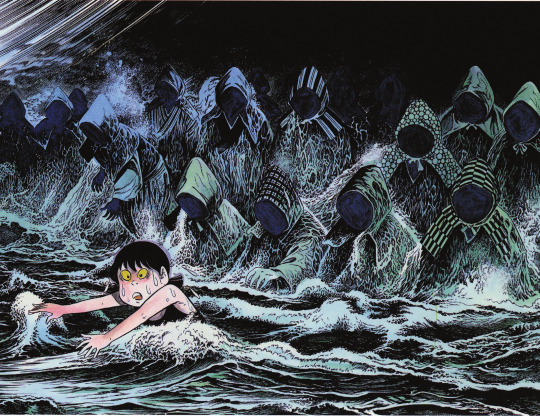

#art#shigeru mizuki#folklore#japan#yokai#akaname#ichimoku-nyudo#ogome#tsurara-onna#hoyau-kamui#ho-onade#tenome#amabie#garappa#kappa#seko#shudan-borei#shirime
140 notes
·
View notes
Text
Compile Hagiography Through Reading the Hyperdimension Neptunia Wiki
12 Days of Aniblogging 2023, Day 4
When I’m really bored on the computer, one of the things I'll occasionally do is explore the Hyperdimension Neptunia wiki. Neptunia is a role-playing series whose main distinction is being centered around moe anthropomorphizations of video game companies and consoles, which fascinates me. These are textbook trashy 6/10 anime RPGs, and release at a pace that suggests both a low budget and a pretty dedicated fanbase. I don’t mean to patronize, though. I’m not above this kind of stuff, I just can’t let a bunch of mid 30-hour JRPGs into my life at this moment in time. Rather, my angle of interest here is the origins of the Neptunia developer, Compile Heart.

listening and learning
You see, back in the late 80s and early 90s, a company called Compile was one of the greats in Japanese home PC gaming. Most of their early output was shmups for the MSX, although they dabbled in a bit of everything, including running a disc magazine to distribute games. Compile’s first hit was Madou Monogatari in 1990, a numberless first-person dungeon crawler with a focus on voice samples. It features a lovable cast, starring young magician Arle Nadja as she attempts to graduate kindergarten, viscerally decapitate an evil sorcerer, and fend off Satan and the girl who’s down bad for Satan. Plenty of remakes and sequels followed, and eventually Compile struck gold with Puyo Puyo, the platonic ideal of competitive falling-block games. To set it apart from the more faceless puzzle games of the era, they reused the Madou Monogatari cast, resulting in a cutesy aesthetic with occasional lingering bits of fucked-up lore.

After porting Puyo Puyo and its sequel to everything imaginable, Compile spent their mid-90s rapidly scaling the company, ultimately biting off more than they could chew. This was an era of serious change as developers moved towards 3D, and consumer preferences moved too fast for Compile to adapt. Some high-profile failures like Madou Monogatari Saturn and Puyo Puyo Dungeon sent the company into a fiscal downward spiral, leading frequent business partner Sega to bail them out by buying the rights to Puyo Puyo. Compile got to finish their in-progress work, including the gorgeous yet frustrating Puyo Puyo 4, but the writing was on the wall. Compile declared bankruptcy in 2003 after throwing all of their hopes and dreams into one last little game, Pochi and Nyaa. It’s a puzzle game with simple yet strategic mechanics that feels like something of a return to infancy for the developers. Also, it was released on the Neo-Geo in 2003! If you know anything about arcade hardware, that’s nuts.
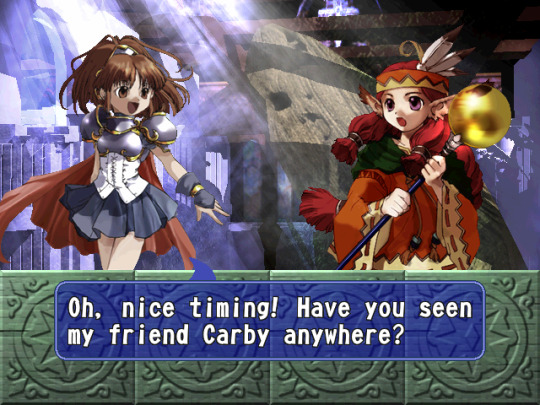
The late 90's pre-rendered backgrounds combined with Sunaho Tobe's character artwork give Puyo Puyo 4 such a special look. Shame it's unplayable unless you're very good at chaining.
So Compile scatters to the winds and a lot of the non-shmup devs regroup at the newly formed Compile Heart, where they eventually hit the jackpot with Hyperdimension Neptunia and crank one of those out per year ad infinitum.
That was a pretty tumultuous history! And Neptunia seems like a way to process this? After all, the protagonist is named after and personifies the Sega Neptune, a cancelled 90’s console. Compile and Sega have intertwined histories and faced a similar trajectory. Rapid success in the early 90s was followed up by bad business decisions later in the decade, leading to a tragic exit from the industry that nobody wanted to see. Hyperdimension Neptunia wants to convey these scars to an audience who weren't necessarily around for it.

The first Neptunia game opens with the anime girl manifestations of Nintendo, Sony, and Xbox deciding that in order to break the sixth-generation console war stalemate, they need to team up against the one who poses the biggest threat. So, they get together and betray Neptunia, casting her out of the heavens. Obviously, this isn’t how it happened in the real world. The Dreamcast may have been awesome, but Sega was operating at a loss trying to support it, and the release of the all-consuming PS2 spelled doom. But this intro is closer to how it felt to Sega fans. It’s a mythical retelling of the fall, one that slots right in with the endless glowing retrospectives of Sega’s glorious but doomed last breath (My favorite is calling the console a “small, square, white plastic JFK”).
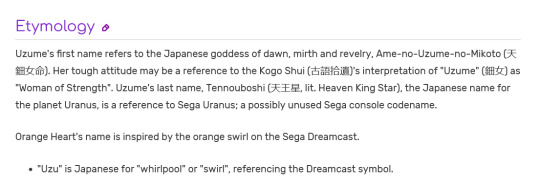
I’m no industry expert or historian, but I was around to see the Japanese game industry flounder during the PS3 era, when high definition brought with it new expectations and inflated development cycles. Obviously juggernauts like Capcom and Square Enix got out fine, but a lot of smaller studios went under at some point in the past 15 years. Hudson, T&E Soft, ASCII, Clover Studio, Imageepoch. In another world, beloved FromSoft could have fallen to the wayside just as easily.
That’s why Neptunia is really important, I think. It serves as a way to self-mythologize, to keep fragments of these studios alive no matter what happens to them later. It’s a snapshot of all the B-tier Japanese game companies at any given point, written by one such company. When some of them inevitably fold, the Neptunia series will act as one more eulogy. As a huge fan of Compile-era Puyo Puyo, it’s a strange but relieving afterlife to witness. I may never play these games, but I’m grateful for what they do, and it’s a very entertaining series to rummage through the wiki of, especially as someone with a known appreciation of OS-tans.
The second Hyperdimension Neptunia game appears to introduce the Gamindustri Graveyard, a burial ground for defunct game companies. Resting there alongside all the other fallen studios is 1st-Gen Compa, the spirit of Compile. She’s wearing an outfit adorned with Puyos, with ears resembling those of beloved mascot Carbuncle. What is just a random horny anime girl for one person is a loving tribute for another. It’s a meaningful way to send off the old.

…and so is raising the dead! In October, Compile Heart announced a new Madou Monogatari game, with Sega giving them the rights to use classic Puyo Puyo characters on the project. According to the press release, the development team includes many staff members who were part of the original incarnation of Compile. Hope springs eternal, somehow.
17 notes
·
View notes
Text
Japanese Movie Recommendations!
こんにちは皆さん!今日、特別な順序ではなく5本の好きな映画を紹介したいです。
Hi everyone! Today I’d like to introduce you to 5 of my favourite Japanese movies! My personal tastes lean more towards the horror and anime side of things, but I hope there are some here that you guys haven’t seen! Cinema can be a great avenue to delve deeper social commentaries about the country we’re interested in learning about, so I’ve tried to pick some recommendations with that in mind! :]
I’ve attempted to add all relevant content warnings, but there may be something I have missed so please take caution! I’d recommend having a look at what people say on DoesTheDogDie.com if you have specific concerns
Without further ado, let’s get started!
1. Confessions (告白) directed by Tetsuya Nakashima (中島哲也)

Confessions is a 2010 psychological thriller based off of the mystery novel of the same name. It follows the aftermath of the murder of a school teacher’s daughter by her pupils, who utilise Japan’s laws on age of criminal responsibility to “get away with it” and focuses on the differing perspectives of those involved. This film explores themes of revenge, familial values and expectations, and the normalization of violence in youth. This film is unmistakably heavy, but it is powerful.
This was introduced to me by my professor when I was doing a Japanese Film course in Uni, and it has stuck with me for YEARS. Not only is the story itself poignant, it’s brilliantly acted, beautifully shot, and has so many striking visuals with artistically composed scenes. As this was a fairly successful film, there are a fair few articles analysing its themes - if anyone is interested, I can try and dig up the resources we used when we studied this in class! :]
Content warnings: depictions and mentions of mental and physical abuse, violence towards children, violence committed by children, bullying mentions of animal death, attempted suicide, murder, mentions of chronic illness (AIDs and cancer in particular)
2. The Tale of the Princess Kaguya (かぐや姫の物語) directed by Isao Takahata (高畑 勲)
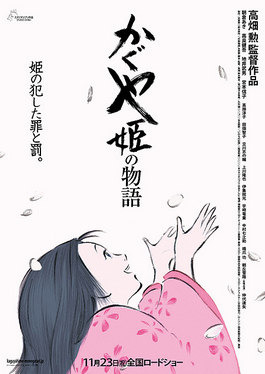
A retelling of famous folktale Taketori Monogatari (竹取物語) for modern Japanese audiences, The Tale of the Princess Kaguya brings new life to the classic story without sacrificing any of its heart. Takahata cited his own inability to connect to the original tale as inspiration for the retelling, aiming for something which the audience could connect to emotionally and really understand the titular princess.
The film deals with feminist concerns about the restrictions of womanhood (especially in the ambiguously Heian-era Japan), familial obligation, love, and the beauty of life. It’s a cultural adventure which I would recommend to anyone regardless of their familiarity with the tale it is adapting! Honestly, I’ve written essays about Taketori Monogatari and this film still managed to move me to tears with how beautifully and painstakingly rendered it is! I’d need a whole other post to detail just how much I appreciate the /art/ of this piece.
Content warnings: animal death, suggestion of sexual assault, arranged marriage, memory loss
3. Dark Water (仄暗い水の底から) directed by Hideo Nakata (中田 秀夫)

This 2002 horror movie is a sad ghost story! It follows the story of a single mother trying to get through her life while dealing with her divorce proceedings, new slightly-run-down apartment, and the paranormal occurrences haunting herself and her daughter. This movie deals with familial issues, parental sacrifice and confronting trauma.
Dark Water deals with aspects of Japanese horror which fans of Ringu (coincidentally, also directed by Nakata) may recognize, so I’d definitely recommend fans of Ringu and people wanting to explore the way that different cultures portray horror to give this one a shot. I found this one so fun to analyse recurring themes and imagery in Japanese horror, and I’m more than happy to encourage others to fall down this rabbit hole too!
Content warnings: missing children, death (including that of a child), threat of death, drowning, abandonment, divorce
4. The Girl Who Leapt Through Time (時をかける少女) directed by Makoto Shinkai (新海 誠)
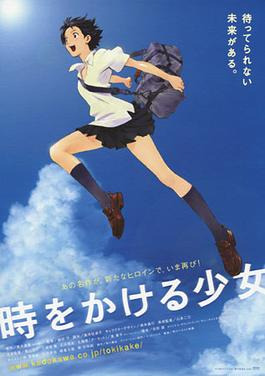
This 2006 sci-fi romance tells the story of a high-school girl who discovered that she has the ability to travel through time! Dealing with friendship, the pressures of growing up and romance, this movie integrates slice-of-life and coming of age themes into its sci-fi setting! Its your classic tale of fairly innocent time-travel shenanigans and trying to right some wrongs, and makes the the ultimate heartwarming story!
This one used to be pretty popular amongst anime fans a gooood few years back, but I haven’t seen people talk about it in a while and I wanted to mention it just in case it had fallen off the radar! With simple yet fluid character designs and beautiful scenery, this piece manages to portray grounded teenage characters and capture that warm summer feeling throughout.
Content warnings: threat of death, train accidents, minor violence and name calling
5. Tokyo Sonata (トウキョウソナタ) directed by Kiyoshi Kurosawa (黒沢 清)
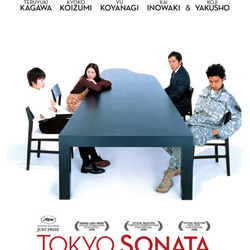
This 2008 drama follows the disintegration of a middle-class family after the patriarch loses his comfortable salaryman job unexpectedly. This film tackles issues faced by many modern families as the sense of traditionalism and societal normalcy becomes strained under the pressures of expectation, unemployment, and inability to communicate your authentic self to your family.
This film is an incredibly grounded drama, depicting real issues faced by so many families. Take a look at the date on this film, and you’ll realise how true-to-home this story of societal and economic uncertainty is for so many. Despite it all, what seems on the surface to be a depressing story of a family at their worst, actually displays a message of hope throughout. I find it to be a very realistic and poignant film.
Content warnings: unemployment, financial struggle, communication issues, war, military, abuse, domestic violence, crime, robbery, kidnapping, themes of suicide and depression, sexual assault, car accidents, police presence
Bonus! Gohatto (御法度) directed by Nagisa Ōshima (大島 渚)
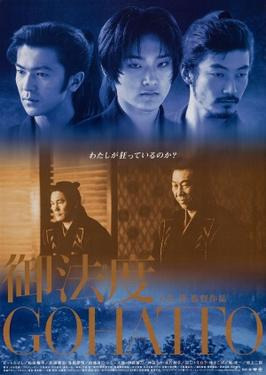
This one was recommended by my flatmate for this list, as a quick shoutout because “its very good” so I don’t personally have much to say about it - but I’m never going to complain about a recommendation for a gay samurai film. :]
それで、おすすめを終わります!
Thank you all for reading through this list! If you have any recommendations of your own, please feel free to add them on!
#leo speaks#japanese#japanese movie#japanese movies#langblr#japanese langblr#movies#film#japanese cinema#japanese study blog#japanese studyblr#film recommendations
50 notes
·
View notes
Text
Top Anime of 2022
Considering that I didn't watch anime for at least 30% of the year, there is a significant amount of anime that I missed. As such, ONAs were counted as series (because they practically are). Certain sequels were also counted because I said so. It's my list, and I can do what I want! I will be putting some honourable mentions (but only the ones I plan on watching... eventually).
Honourable Mentions (PTW):
Sasaki to Miyano
Heike Monogatari
Summertime Render
Paripi Koumei
Lycoris Recoil
Kumichou Musume to Sewagakari
Cyberpunk: Edgerunners
TOP 11:
There wasn't enough to make an "honourable mention" list for the ones I had completed. For one, some of the shows that I completed were not good. Vampire in the Garden was incredibly rushed with an ending that made less and less sense the more I thought about it (but A for effort as it felt like watching Vanitas but with more likable girlbosses). AkuLas (not gonna bother typing out the full name) just wasn't good, so I'm not even going to give it any more time besides saying it wasted mine, the pacing was wack, and the voice acting tried to carry a story that wasn't there.
This ranking was very hard to make. It was incredibly difficult for me to weigh if I should put things higher based on my enjoyment or something else being objectively and critically better. Because of that, a lot of this ordering isn't set in stone, especially for the top places.
11. Koi wa Sekai Seifuku no Ato de
The first three slots are incredibly heavy on fanservice. Despite my aversion towards it (and the fact that it was distracting), I found myself still enjoying this show. It's very lighthearted, cute, and does exactly what it sets out to do and nothing more than that. Also, some things in this are better to just not think about. What the heck are those talking animals? Just don't think about it. It's all good.

10. Isekai Ojisan
Maybe it's because I caught up on this recently, but as it stands right now (with many of the episodes locked up by Netflix for whatever reason), this is going to take the #10 spot. This show was refreshing, funny, but a little bit too heavy on the fanservice (seriously, it turned into a h*ntai at some points). Regardless, I still found it very funny at the very least. It subverts many of the tired isekai tropes to make a very unique parody.
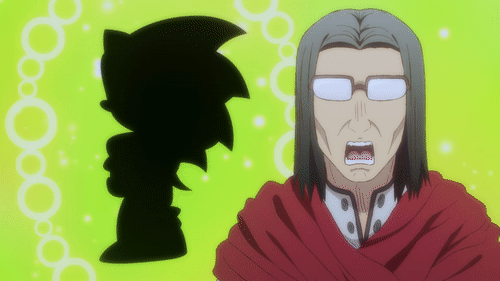
9. Sono Bisque Doll wa Koi wo Suru
I personally don't like fanservice, but this show was still cute as heck. I really like both of the main characters even if Marin is a bit (very) pushy (accidentally). I'm not as attached to the other characters, but that doesn't really matter because I like the main two a lot. Of course, the art is good. I personally didn't like the OP or ED that much even if they were incredibly catchy. Overall, a solid romance that I would rewatch like chicken noodle soup for the soul, and I'm very much looking forward to the sequel.

8. Chainsaw Man
This was a good show, but I found the cast of characters to be the weakest part of the show. It's not that I hate nor dislike them. I just didn't grow attached to them. As refreshing as it is to have a protagonist who's very clear in his intentions and goals not being about the good of society and/or friendship, I was not entirely sold on liking him as the character. On the other hand, everything else about this anime and the production value was absolutely amazing. The voice acting? Perfect (I do like that casting). The animation? Spectacular. The music? Immaculate. This could easily critically knock out further entries on this list.

7. Kotaro Lives Alone
This is the anime that probably caught me the most off-guard. This anime's character design looks awful. I was going to skip it based off that, but after watching it, I can say that I came away shaken (in a good way). The way this show portrays child abuse, emotional abuse, domestic abuse, and other heavy topics is absolutely masterful. It left me kinda emotional. I think they made Kotaro the perfect balance of mature and childish at the same time (because watching a realistic child in his circumstances would be unwatchable).
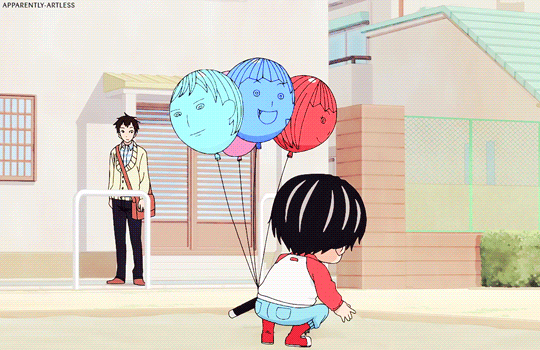
6. Bocchi the Rock!
"She's just like me fr fr!" This show got the inner dialogue of my brain, and as someone who dropped out in high school and never got that "seishun youthful blue spring" time, I felt a lot of the sentiment that Bocchi feels. I even tried joining a band (but jazz). This show is incredibly funny and uses visual humour skillfully. The voice acting is some of the best I've seen from relatively newer voice actors. That scream lives in my mind rent-free. This is basically K-On mixed with my existential dread and sense of humour. Fantastic.

5. Kimetsu no Yaiba: Yuukaku-hen
Bro, this felt better to watch than it was reading the manga, and that's saying something! The manga was still good, but this really solidified Demon Slayer as an absolute powerhouse! I know people are saying that it lacks the depth of Chainsaw Man or Jujutsu Kaisen, but I don't think things need to be complex to be good. Maybe I just want to see someone slashing some demons.

4. Spy x Family
This is peak Shonen Jump slice-of-life. Honestly, the only episodes and arcs that were a bit of a bore were still necessary and just lacked Anya. Besides that, this show was magnificent (running out of good synonyms). Anya is one of my favourite characters of the year. She's stupid but extremely caring even if she's a bit off the walls.
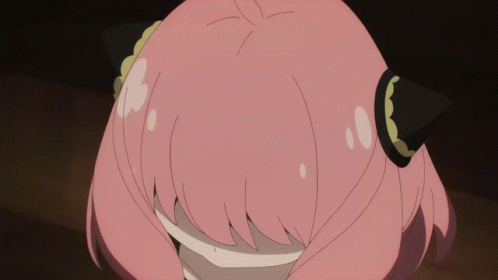
3. Romantic Killer
Anyone with Netflix or a pulse should go watch this show. I wrote a whole thing about it.
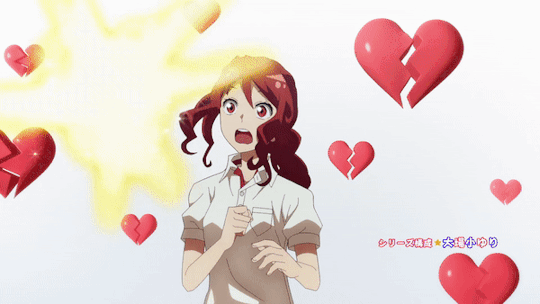
2. Kaguya-sama wa Kokurasetai: Ultra Romantic
I'm not sure what I can say about this show that hasn't been said already. It's a masterclass in romantic comedies, and it doesn't need fanservice (ignore the OVA) to succeed at making a ton of witty parody and comedy that transcends language in itself with an endearing romance that you can't help but root for. The openings are also iconic. Masayuki Suzuki is the king of love songs.

1. Mob Psycho 100 III
Just like Kotaro Lives Alone, this anime has a uniquely simplistic art style, but don't let that fool you, both of these anime are incredibly good at storytelling. Studio Bones cares about this series a lot, and you can see it through this anime. This is one of the best coming-of-age stories I've seen, and this season was a perfect finale to a story that we've been watching since the beginning. Everything about and from this anime range from great to exceptional.

#mob psycho 100#mp100#kaguya sama wa kokurasetai#kaguya sama love is war#romantic killer#spy x family#kimetsu no yaiba#demon slayer#bocchi the rock#bocchi the rock!#chainsaw man#sono bisque doll wa koi wo suru#isekai ojisan#koi wa sekai seifuku no ato de#top anime of 2022#anime of 2022
37 notes
·
View notes
Note
I[175cm] find the idea of people swooping in and being in random posters in circles they're not involved explicitly and directly involved in kind of insane and peculiar. Thus why I described myself as impish slinking around and adding little bits of world building to the anaonymous asks. Crazy to think its an entire thing. I really thought I was original... damn... also thanks for the renders, they remind me that I have all the novels and downloaded and I need to read them. For all the Imp fans out there my favorite Monogatari character is Kaiki. It's a basic answer but it's true.
i think it's fine for new people to join friend groups and it's entirely fine to do so. all it takes is one person to bring them in... but i guess on your own it would be a bit awkward to do so
going about it through an askbox arg is pretty interesting tho. Kaiki, huh?
2 notes
·
View notes
Text
UNO STRANO EFFETTO DELLA PAROLA "CORAGGIO"
Tempo fa ho visto tutte le serie di un anime (così si chiamano i cartoni animati giapponesi) intitolato "Monogatari".
L'opera è un capolavoro con personaggi complessi e dialoghi memorabili, malgrado alcuni classici difetti di molti anime, come la presenza sovrabbondante del cosiddetto "fan service", spesso caratterizzato da ammiccamenti del tutto gratuiti a talune perversioni (che includono forme di molestia sessuale) senza neppure un accenno di collegamento alla trama o allo sviluppo dei personaggi.
Non scendo nei particolari perché a questo profilo sono affezionato e non voglio correre il rischio che sia disintegrato dalla spietata polizia democristiana dei social network. Oggi mi gira così. Voglio che il post sia completamente asettico.
A proposito, mi è tornata in mente la scena in cui un personaggio femminile fa una scommessa con Koyomi Araragi, il protagonista. La posta in palio è collegata alle perversioni del ragazzo. Ma la questione più interessante è proprio l'oggetto della disputa.
Lei scommette di poter dimostrare che la parola "coraggio" si può usare per manipolare la comunicazione e descrivere qualsiasi azione esecrabile come se fosse un comportamento degno della massima stima.
Basta aggiungere "coraggio" e il gioco è fatto.
Per essere convincente fa diversi esempi allo scettico Araragi. Non li ricordo tutti, quindi alcuni devo inventarli, ma il concetto non cambia. Tanto per rendere l'idea, ecco un piccolo elenco: il coraggio di far del male a qualcuno, il coraggio di tradire gli altri, il coraggio di mentire, il coraggio di ingannare, il coraggio di sacrificare vite umane, il coraggio di sganciare una bomba.
Alla fine Araragi si arrende e lei vince la scommessa.
Ho ricordato questa scena quando Salvini ha pubblicato una foto per mostrare se stesso in posa eroica. Nella foto c'era una barca in mezzo al mare, piena di migranti in fuga dalla disperazione. E c'era anche la scritta: «Torna la sicurezza, torna il coraggio».
Già, proprio quel coraggio lì...
[L'Ideota]
47 notes
·
View notes
Text
The Monogatari Series, Nonlinear Storytelling, and Arc-Weaving
Over the past half-year or so, I've gotten pretty into the Monogatari series. Or, more precisely, into the first three seasons thereof, since that's the current end-point both of the English-translated novels and of the anime. The series has a lot of interesting stuff going on—I wouldn't be surprised if I ended up making several posts about it over the next while—but one thing it does which strikes me as particularly warranting analysis, for purposes of extracting its techniques for use in my own writing, is its employment of nonlinear storytelling.
(Below the cut: Monogatari series spoilers through the end of the third season (also known as the Final Season).)
1. Introduction
The Monogatari series, over the course of its first three seasons, is very aggressively nonlinear. Chronologically, if we oversimplify somewhat by ignoring framing stories and pretending that each book takes place at a single point in the timeline whenever we can get away with doing that, we end up with this mapping between reading order and chronological order:
Bakemonogatari, Part 1 (chronologically #3)
Bakemonogatari, Part 2 (chronologically #4)
Kizumonogatari (chronologically #1)
Nisemonogatari, Part 1 (chronologically #5)
Nisemonogatari, Part 2 (chronologically #6)
Nekomonogatari (Kuro) (chronologically #2)
Nekomonogatari (Shiro) (chronologically spans the range from #7 to #9 (inclusive))
Kabukimonogatari (chronologically #7)
Hanamonogatari (chronologically #17)
Otorimonogatari (chronologically #11)
Onimonogatari (chronologically #8)
Koimonogatari (chronologically #12)
Tsukimonogatari (chronologically #13)
Koyomimonogatari (chronologically scattered, covering points throughout the span between 1 and 13, with its ending being chronologically #14)
Owarimonogatari, Part 1 (chronologically #10)
Owarimonogatari, Part 2 (chronologically #9)
Owarimonogatari, Part 3 (chronologically #15)
Zoku Owarimonogatari (chronologically #16)
...so, of seventeen books-which-follow-other-books, only a total of four take place straightforwardly immediately after the prior book in the reading order, and two of those four are Bakemonogatari and Nisemonogatari's respective Part 2s, which arguably shouldn't even count, since there's a decent argument to be made that the splits there (particularly the Bakemonogatari one) are purely a product of publishing logistics rather than of true narrative structure.
(Unlike Owarimonogatari, whose parts' separation is very much structural and clearly not just a publishing limitation.)
The first important thing to note about this nonlinearity is that it works. It actively bolsters the quality of the narrative, relative to what a more straightforward chronological rendering would do. And, sure, nonlinear storytelling is done to some extent all over the place, but I've rarely seen it employed as effectively as the Monogatari series employs it on the scale that the Monogatari series employs it at. Which leads to a natural question: what, exactly, is Monogatari doing which would make this superficially-horribly-tangled mess actually sensible as a way of ordering its narrative?
To state my major theses in advance: the nonlinearity of the Monogatari series serves at least three major functions, in addition to probably various more which I have yet to identify. First: it serves as a way to ensure that there are almost always outstanding mysteries and hanging plot threads, thus helping to keep viewers engaged even at points in the timeline where the characters are experiencing their lives as primarily episodic. Second: it allows characters' true natures to be unveiled in a relatively slow and gradual fashion, even in cases where, chronologically, it would become clear relatively early on what their deals are. And third: it allows for interweaving of multiple plot arcs in such a way as to control macro-scale narrative intensity through micro-scale decisions of which arcs to focus on at a given point.
With that bit of signposting out of the way, let's dive into details!
2. Loose Plot Threads
Throughout the three seasons under examination here, there are a grand total of three books after which a reader might reasonably feel like all established mysteries and plot threads have been resolved: Nekomonogatari Kuro, Owarimonogatari Part 3, and Zoku Owarimonogatari. Aside from those three, at any given point in time, there are always things kept conspicuously mysterious:
Bakemonogatari Part 1 establishes Araragi's history with Shinobu over spring break, and Hanekawa's history with the cat that enchanted her over Golden Week, as hanging threads of Backstory Mystery; the former isn't explained in detail until Kizumonogatari, while the latter isn't explained in detail until Nekomonogatari Kuro.
Nekomonogatari Shiro establishes a whole gigantic pile of mysteries regarding Araragi's offscreen adventures. Did Hachikuji ever get her backpack back? Why was Araragi missing from school? What did he need Kanbaru's help with? What broke his connection to Shinobu? What were Gaen, Episode, and Ononoki doing in town? Under what circumstances did Araragi ended up equipped with Kokorowatari while wearing shredded clothes? Et cetera. These get resolved only slowly via drip-feed over the course of Kabukimonogatari, Onimonogatari, and Owarimonogatari Part 2.
Kabukimonogatari establishes the mystery of what Ougi's deal is; subsequent books, particularly Otorimonogatari and Onimonogatari and Koimonogatari, deepen the mystery; it gets resolved only in Owarimonogatari Part 3.
Otorimonogatari establishes the mystery of what's up with the snake-god-talisman in Araragi's room, as well as the mystery of how we saw him alive and Senjougahara and Shinobu discussed-as-though-alive post-graduation in Hanamonogatari despite Nadeko's intention to kill the three of them; these are both only resolved in Koimonogatari.
...et cetera.
What all of this amounts to is that, from the moment they figure out the pattern where the Monogatari series is reliable in eventually filling in whatever plot threads it leaves open, readers will be driven forward in their reading, not just out of interest in the current plot-episode, but also out of interest in learning the answers to those previous hanging mystery-threads. They'll be driven forward this way even during moments when, from the chronological perspective through which the characters are viewing things, events are happening in a relatively episodic fashion, routinely resolving without obvious hanging threads.
That point about 'from the moment they figure out the pattern', incidentally, is among the reasons the first season is as structurally important as it is: in addition to its role in character-establishment, it also fills the crucially-important role of teaching the readers that those loose threads will eventually be returned to and tied off. If not for the first season ending the way it does, with Nekomonogatari Kuro tying off the last of the major loose mystery-threads, audience members might well read Nekomonogatari Shiro and go "huh, guess Araragi is having a bunch of offscreen adventures" and leave their thinking off there, rather than regarding them as the mysteries-to-be-eventually-resolved that they in fact are.
This, then, is one advantage the Monogatari series gains from its nonlinearity: the nonlinearity serves as a source of long-running mysteries, and thereby increases narrative engagingness for those inclined in the direction of trying to solve a story's mysteries as they read.
3. Slow Unveiling of Characters
Separate from the matter of plot-level mysteries as discussed in the prior section, the Monogatari series also uses its nonlinear story-ordering in order to establish and develop character-level mysteries. There's some sense in which the two are closely related; but there's another sense in which they're very different, because character-level mysteries tend to be written differently from plot-level mysteries, with more focus on the introduction of many successive levels of greater detail, rather than a single decisive moment of "ah, this now makes perfect sense".
Let's use two examples as models here: Hanekawa Tsubasa and Oshino Ougi. Various other characters are, to one extent or another, handled similarly, but those two are, I think, the most clear and blatant examples of the thing.
Hanekawa Tsubasa is established more-or-less immediately as, to put it in TV Tropes terms, The Ace. A class president among class presidents, who, despite always denying knowing everything, sure does seem to know a whole lot, even to the point of occasionally responding directly to Araragi's internal monologue without waiting for him to verbalize it first. (Although this habit of hers is sadly omitted from the anime.)
In her first in-focus arc, Tsubasa Cat, we get hints of prior events in Golden Week, we learn more of her limits, and we learn of her love for Araragi; but we learn relatively little about the deeper details of how she works or what makes her tick. Kizumonogatari shows more of her personality and her relationship with Araragi, but once again teaches us relatively little about her internal state. That information on her internal state is instead successively doled out over the two Nekomonogatari stories, with Kuro showing more of her family issues and making explicit her tendency to act in whatever fashion she parses as Correct and Virtuous irrespective of considerations that might make others do otherwise, and Shiro making explicit her tendency towards repressing whatever negative feelings she might have about everything, her inability to ask for help, and in general most of what's left to show of her personality and flaws, just in time for readers to have full context on what's happening and why it's significant when she has her Big Character-Development Moment at the end.
As written, this is a highly-effective slow unveiling of how she works as a character. And, importantly, it wouldn't have worked as well, if it were told chronologically. Kizumonogatari shows us more of her than Bakemonogatari does, and Nekomonogatari Kuro, in turn, shows us more of her than Kizumonogatari does. Her story, presented chronologically, would thus have had a flat spot around Tsubasa Cat, in which she receives noticeably less development than she does in Nekomonogatari Kuro. By going nonlinear in the telling of Hanekawa's story, we instead get a nice smooth curve of escalatingly-detailed establishment of her character in each of her in-focus arcs.
Where Hanekawa's slow unveiling is largely of her flaws, Oshino Ougi's slow unveiling is different: it's largely about her motives. When we first meet Ougi, it's in the flashforward at the start of Kabukimonogatari, chatting with Araragi about traffic lights; we get to see something of her personality right away, in that conversation, but we learn very little of her larger role in things. in Hanamonogatari, Ougi spends his appearance similarly, making idle conversation and introducing Kanbaru to the Lord Devil rumor-set; but this time there's a bit more focus put on how it's odd how quickly he integrated himself into Araragi's social sphere. And, early on in Otorimonogatari, we get a similar-seeming conversation between her and Nadeko, this time with attention drawn to her being familiar with Nadeko but not vice versa.
But it's only near the end of Otorimonogatari that we get to see Ougi in clear goal-pursuit mode: telling Nadeko about the talisman in Araragi's house, and giving her the scrunchy which ends up serving as the basis for Kuchinawa-san. From there, her appearances continue being much more ominous: drawing parallels between herself and the Darkness in Onimonogatari, tailing and sending a deranged middle-schooler after Kaiki in Koimonogatari* (and having it confirmed that her supposed identity as Oshino Meme's niece is a lie), having her blatantly-mocking conversation with Araragi in Tsukimonogatari while he continues to entirely fail to recognize her as a potential threat (as well as being implied to have been the one to set the Tadatsuru situation into motion), et cetera.
Finally, in Owarimonogatari Part 1, we get to see her in full focus, finally showing up as a main character rather than just a side character, and to see more of what it is that she's doing with Araragi, forcing him to confront the various memories that he'd prefer to leave repressed. And this all leads up to Owarimonogatari Part 3, where her true nature is finally unveiled in the course of her big confrontation with Araragi.
Viewed chronologically, Ougi's trajectory of development would be far less interesting. Without the setup of her initial mildly-suspicious-but-not-obviously-antagonistic appearances, there wouldn't be the same degree of impact when her status as actually-an-antagonist is revealed at the end of Otorimonogatari and driven home over the next few books. (And she is, very much, blatantly antagonistic over the course of Owarimonogatari Part 1, even if her antagonism in that case might not have had as much in the way of dire consequences as it did in Otorimonogatari.)
Moreover, told chronologically, much like Hanekawa's, her arc would have felt lopsided: she's get a single big appearance at her introduction, then spent a while being ominous and occasionally causing trouble in the background, and then... suddenly come into focus as the Big Final Antagonist of the Final Season? Whereas, by presenting her appearances nonlinearly in the way they do and leaving her chronologically-first appearance for the start of Owarimonogatari, the novels instead build her up in a proper slowly-escalating trajectory: she starts out as a mysterious character who will probably be important later, advances from there to an antagonist moving against Araragi in the background for still-largely-mysterious purposes, and then advances from there to an actively-in-focus antagonist whose motives are slowly becoming clearer, leaving her spot in the Big Final Antagonist role as a natural culmination of the patterns of narrative escalation surrounding her up to that point.
While Hanekawa and Ougi are, to my eyes, the two most clearly illustrative examples of the pattern, they are by no means the only examples. Similar pictures could be drawn around Kaiki (Hanamonogatari setting up his soft spot for Kanbaru in time for it to factor naturally into his actions in Koimonogatari), around Araragi himself (see e.g. how late we learn about the origins of his justice-related cynicism), on a smaller scale around Oikura Sodachi (it happens within a single book, there, but there's still a definite nonlinearity to how she gets developed within that book), et cetera.
This, then, is another major benefit the Monogatari series gets from its nonlinearity: by establishing and developing its characters in a chronologically-nonlinear fashion, it ends up able to smooth out the trajectories of said establishment/development, to make each step feel satisfyingly escalatory from the last in a way that wouldn't be practical if those trajectories were additionally constrained by chronology.
4. Arc-Weaving
Although the series as a whole is, as discussed in the introduction, aggressively nonlinear, there's an alternate angle by which to look at it under which it appears somewhat more linear: that of the narrative arc. Consider these three major arcs:
Shinobu's past comes back to haunt her. (Kabukimonogatari, Onimonogatari, Owarimonogatari Part 2, also sort of marginally Nekomonogatari Shiro)
Sengoku Nadeko causes trouble. (Otorimonogatari, Koimonogatari)
Oshino Ougi causes trouble. (Otorimonogatari, Koimonogatari, Tsukimonogatari, the final parts of Koyomimonogatri, Owarimonogatari Part 1, Owarimonogatari Part 3)
...and note that all of these arcs are actually primarily linear. The only points of nonlinearity in these arcs are Owarimonogatari Part 1 in the Ougi arc and the very small Shinobu-focused bit in Nekomonogatari Shiro; aside from those two, these arcs are presented entirely in chronological order.
(And, indeed, between these three arcs, we end up touching on the majority of the books in the second and third seasons, excepting only Hanamonogatari and Zoku Owarimonogatari (since those two both take place after these three arcs are already concluded, and serve other narrative functions instead).)
So, in a sense, one could view the Monogatari series as actually relatively light on nonlinearity, at least within the second and third seasons. Rather, in this framing, what it's doing is telling several approximately-linear stories in parallel with one another.
I wouldn't say that that view is the One Correct View into the Monogatari series's nonlinearity, or anything. But I would say that it's a useful view into it. Because this view opens up the question: okay, so we've got these three arcs, each of different length in number-of-books, each taking place over a different chunk of the timeline (even if the beginnings of the Ougi arc happen to be concurrent with the entirety of the Nadeko arc). Why are they intertwined the way they are? What advantage is gained, narratively, by intertwining them instead of telling them sequentially? We established in the previous section why Owarimonogatari Part 1 belongs where it does, sure; but why not tell these stories in chronological order aside from that one divergence therefrom, with all the Shinobu's-past stories coming before all the Nadeko-and/or-Ougi-causes-trouble stories?
Well, one reason is the one discussed two sections ago, about leaving mysteries open to drive continued reader curiosity. But another is this:
As a narrative arc goes on, its intensity tends to increase. Not in a continuous fashion—standard trajectory tends to look more like "start at intensity I, escalate to I + 4, drop down to I + 2, escalate to I + 6, et cetera"—but still very much in a fashion which leads to a clear increase in intensity over time, with the arc ending soon after it hits its highest point intensity-wise. When arcs don't do this, when their highest-intensity points sit more towards their middles than towards their ends, this tends to reduce their overall effectiveness. As a corollary of this, the longer a narrative arc goes on, the more intense it tends to be—and needs to be, to land optimally—by the time of its conclusion. However, longer arcs often take longer to initially get moving, compared to shorter ones.
(See, in this very set of examples, the Ougi arc, and how much longer it takes to get moving actively compared with the other two.)
The Monogatari series has these different arcs, each with their own varyingly-fast rates of escalation and varyingly-intense conclusions. But it also has a separate structural factor at work: its seasons. While the first season is doing something else, the second and third seasons each follow an escalatory trajectory not so different from the one I was just ascribing to individual plot arcs: start relatively slow, escalate as things move forward towards the season finale, and then end once said finale is passed, leading into the next season, which starts and ends at a somewhat higher level of intensity.
(I am, here, counting Owarimonogatari Part 3, rather than Zoku Owarimonogatari, as the third season's finale. NISIOISIN himself, in the Zoku Owarimonogatari afterword, describes Zoku Owarimonogatari as a "bonus installment", with Owarimonogatari Part 3 as "the actual final volume"; as far as this structure of escalation-over-the-course-of-the-season goes, I'm in complete agreement with him.)
What interweaving the separate arcs enables, then, is a far more fine-grained level of control over narrative intensity at the season level. Both seasons' finales coincide with an arc finale, to lend them proper intensity: the second season with Koimonogatari resolving the Nadeko arc, the third season with Owarimonogatari Part 3 resolving the Ougi arc. But the third season, remember, is trying to escalate its intensity to a higher level than that of the second. So the second season finale coincides with the finale of a relatively-short arc, two books long, and this is impactful. But the third season finale coincides with the finale of a six-book arc, and, moreover, immediately precedes this with the finale of the Shinobu arc. Owarimonogatari Part 2, placed elsewhere, could easily have been season-finale-tier material in its own right; but, instead, it's used as an escalatory step by the third season, a prelude to the true finale of Owarimonogatari Part 3.
And this works! It works excellently! Koimonogatari makes for a highly satisfying ending to the second season, resolving the previously-built-up tension with Nadeko plus giving us Kaiki's highly-entertaining narration plus stepping things forward on the Ougi front; Owarimonogatari Part 3, meanwhile, is one of the most impactful finales I've encountered anywhere, not even just in the Monogatari series, serving as the culmination of essentially everything up to that point, feeling properly escalatory even coming on the heels of Owarimonogatari Part 2 and its own status as a highly-built-up arc finale.
So, in short, by carefully controlling the rate at which each individual arc is advanced, the Monogatari series ends up in a position of far more fine-grained control over the intensity of its overall interwoven narrative; it then proceeds to use this control in order to maximize the impact of each season's later portions—ending the second season with the middle of the Shinobu arc followed by the end of the Nadeko arc, and the third season with the middle of the Ougi arc followed by the end of the Shinobu arc followed by the end of the Ougi arc (followed by Zoku Owarimonogatari, which isn't really part of this pattern)—all without doing anything to undermine the impact of the individual arcs as individual arcs. It's a beautifully-elegant trick—one I'm not sure I've ever seen used anywhere else, and which I definitely haven't recognized anywhere else—and one that I very much hope to incorporate into my own writing some day.
Conclusion
This is, for the moment, as far as I've gotten in picking apart what it is that makes the Monogatari series's structure (over the span of the first three seasons, at least) work as well as it does. It seems likely that I'm missing things, still; it would be surprising, if I managed to get everything, especially given having only been thinking on the topic for a couple months thus far.
(As of even just a month ago, I hadn't yet figured out the slow-character-unveiling part; I expect there are other similarly-significant things which I still haven't figured out, which I'll figure out over the upcoming months or years, or perhaps never figure out at all.)
This was an interesting and helpful topic for me to think through, increasing my appreciation for the elegance with which the Monogatari series is structured while adding new tricks into my writing arsenal (where, previously, I'd mostly lacked a solid understanding of how to employ nonlinear storytelling effectively). I hope that, in posting it, it will now get the chance to be similarly interesting and helpful for others.
Footnote
* It seems likely that the attack was real, even if Kaiki's death was a lie, given Gaen's mention of his being in hiding and given Ougi's subsequent indication that she did something to him.
23 notes
·
View notes
Text
Process - Sunakawa Cake 🎂
A little breakdown of how I made my 3D recreation of the "thank you sunakawa" cake from Ore Monogatari ~

1. Collecting reference
Aside from referencing stills from the anime, I came across the official cake sketch from Madhouse's website! It was really helpful in identifying all the toppings on the cake and other details.
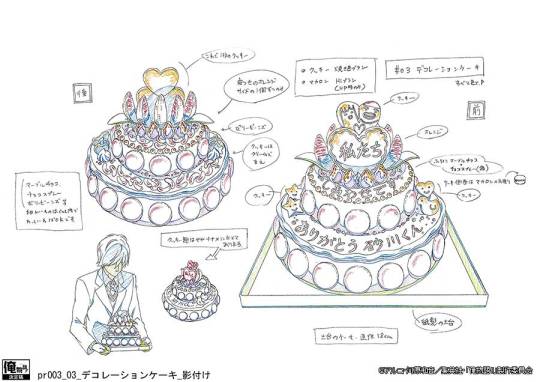
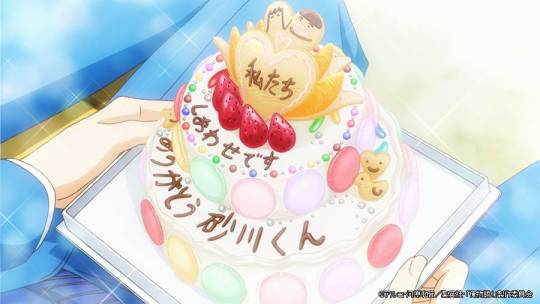
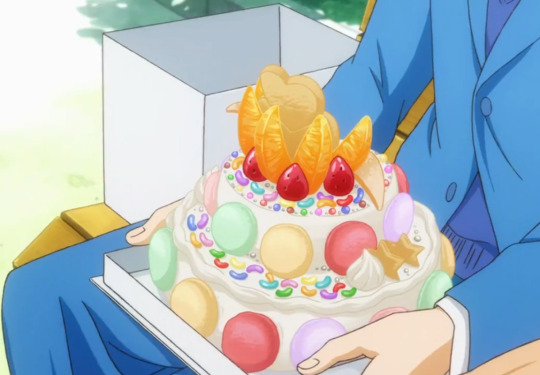
Next was collecting real-life references of all the ingredients I needed to make and taking notes of the shapes, textures and variety.
2. Modelling & Texturing
I go back and forth between modelling and texturing, and jump all over the place so I'll break things down based on the toppings/elements:
A. Macaron
I referenced Canosie Lab's macaron tutorial here, tweaking the process a little bit; using one mesh instead of two and using particles to distribute the boolean meshes. I ended up with LOTS of vertices, so I made a lower poly version of the macaron and used those to avoid bogging down the computer. As for the texture, I used Blender's procedural nodes, utilizing mostly the noise texture node.

Above: The first row are the lower poly versions of the macaron and the second row are the original meshes with around 200,000 vertices each o_o
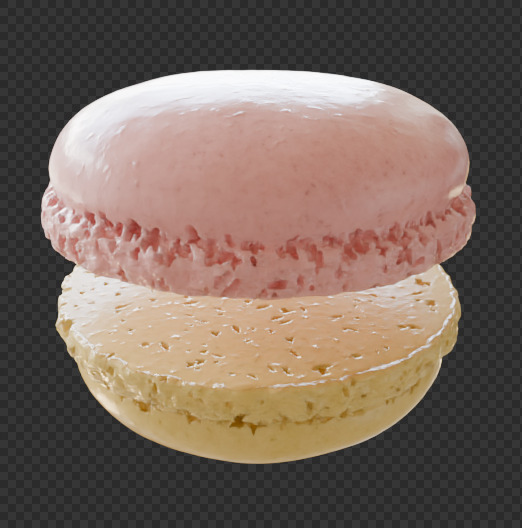
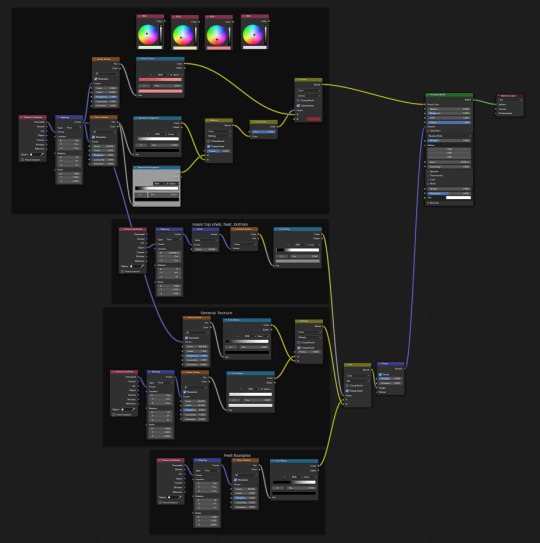
B. Cookies
There's not much to it here; I just modeled the cookies and used procedural textures I've made for a previous project (I'll post that project soon!!!)
The icing is made using bezier curves with some bevel depth. I used the draw tool to draw on the cookies. I did the same for the writings on the cake.
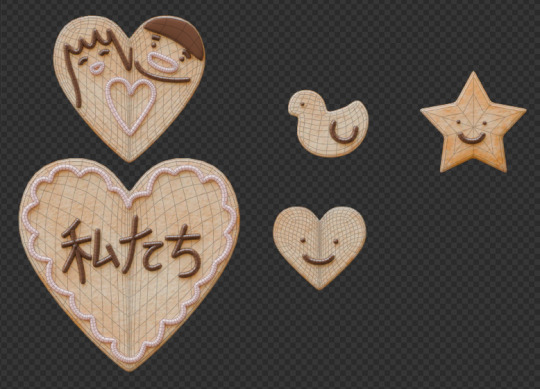
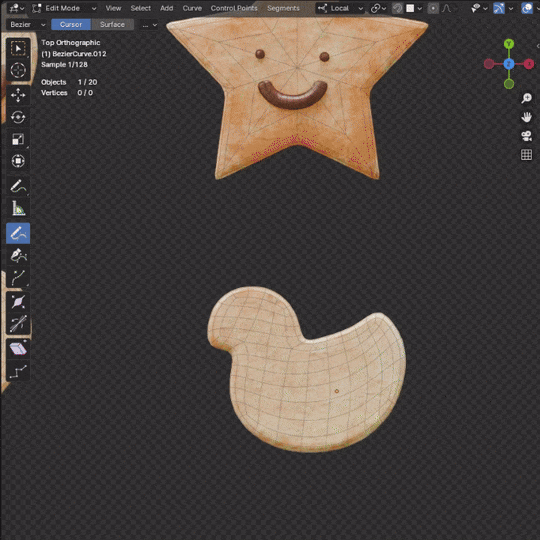
C. Strawberries
I've previously made strawberries for another project so I just used those but baked them to a lower poly mesh first. I used Canosie Labs' strawberry tutorial as reference :) I initially used a scaled down version of the regular-sized strawbs, but decided to make a proper mini strawberry 🍓


Left: with scaled down regular strawberries, Right: proper mini strawberries.

I made them super shiny with lots of subsurface scattering to make them look juicy and gummy-like -- not the most realistic but I think they look cuter like this :>
D. Orange slices
The orange slices were the most challenging to make! Did a lot of trial and error to get that pulpy texture oranges have but I managed using a combination of voronoi nodes :") If you look at the pictures below, you can see how the orange looked in the beginning vs. at the end after I refined it some more.
They look fine from a distance but a little janky up close; maybe I'll do a breakdown one day once I figure out a proper node setup.
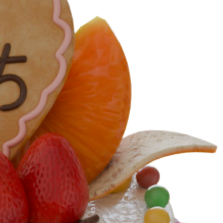
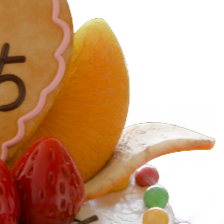
Above: before & after
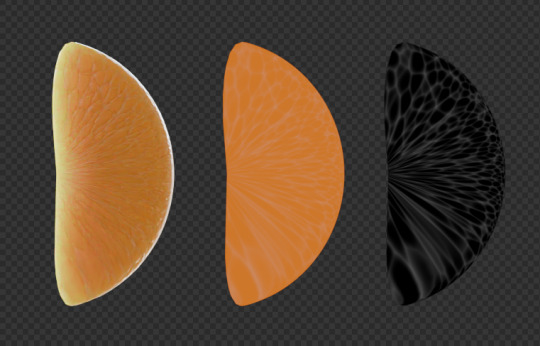
Left to right: rendered, colour only, B/W
E. Orange peel
A simple plane with a solidify and curve modifier. What's most important here is the texture! I used two different shaders (one for the pith another for the peel) combined using a mask.

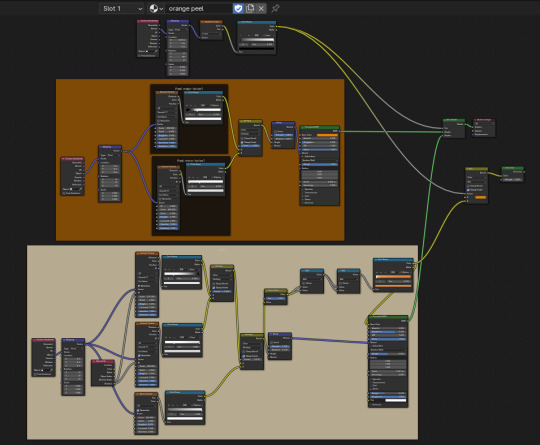
F. Jelly beans & choco marbles
A tweaked subdivided square for the jelly beans and subdivided icosphere for the choco marbles. The two use pretty much the same shaders but the jelly beans have more subsurface scattering.
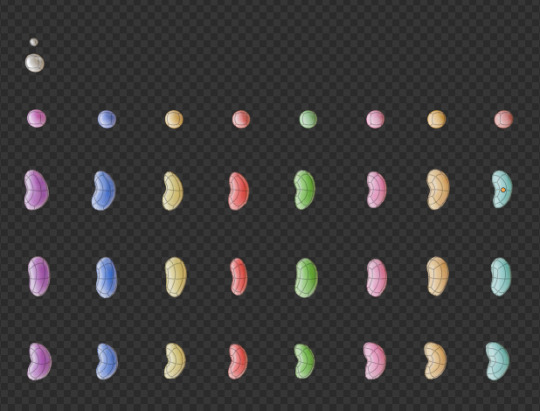
H. Cake
After placing all the toppings, I sculpted the cake (using the multires modifier) a little bit to model the cream that's displaced.


#ore monogatari#sunakawa makoto#process#3d modeling#artists on tumblr#blender#blender 3d#3d model#cake#b3d#3d art#3d render#3d#digital art
20 notes
·
View notes
Text
youtube
Warning: Violence, spoilers, flashing lights
Title: Counting Stars
Editor: Sota
Song: Counting Stars
Artist: OneRepublic
Anime: Violet Evergarden Sasami-san @ ganbaranai, Princess Connect! Re:Dive, Magia Record, Akudama Drive, Kimetsu no Yaiba, Yuru Yuri, Kara no Kyoukai, Monogatari Series, Bungou Stray Dogs, Kaguya-sama: Love is War, Bofuri, One Piece, Megalo Box, Tamako Market, Uzaki-chan, Dumbbell nan kilo moteru?, Sword Art Online, Konosuba, "Sentouin, Hakenshimasu", Shoujo Kageki Revue Starlight, Hibike! Euphonium, Koutetsujou no Kabaneri, K-On, Clannad, Akebi-chan no Sailor Fuku, Grand Blue, Hanebado, Sirius The Jaeger, Shingeki no Kyojin, Link Click, Kimi no Na Wa (film), God Eater, Owari no Seraph, Sekai Saikou no Ansatsusha, Senran Kagura, Touhou, Fate Heaven's Feel (film trilogy), Danganronpa series, Jujutsu Kaisen, Majo no Tabitabi, Prison School, Kakegurui, Date A Live, Tokyo Ghoul, Plastic Memories, Fate Babylonia, Puella Magi Madoka Magica, Blood-C, Black Rock Shooter, Sukasuka, To aru Majutsu no Index, Takt Op Destiny, Gleipnir, Peach Boy Riverside, Darling In The FranXX, Danmachi, Chainsaw Man, Mushoku Tensei, Haifuri, Touken Ranbu, B The Beginning, Oda Nobuna no Yabou, K Project, Mob Psycho 100, Flip Flappers, One Punch Man, Akame ga Kill, Mirai Nikki, Fate Unlimited Blade Works, Vivy Fluorite Eyes Song, Gakusen Toshi Asterisk, Sword Art Online Progressive (film), Angel Beats, Hyouka, 5cm per second (film),Komi-san Can't Communicate, Teasing Master Tagaki-san, Eromanga Sensei, Classroom of the Elite, Hinako Note, Guilty Crown, Dororo, Cyberpunk Edgerunners, Bocchi The Rock!, Engage Kiss (mixed media), Higurashi no Naku Koro ni series, Kore wa Zombie Desu Ka?, Summer Time Rendering, Amagami, Charlotte, Wonder Egg Priority, Scissor Seven, Vinland Saga, Tsukihime Remake (PV), Pretty Derby Uma Musume, Honkai Impact 3rd (game), Lycoris Recoil, Strike The Blood, Noragami, Taboo Tattoo, Princess Mononoke (film), Boku no Hero Academia, Inazuma Eleven, Fate Kaleid Liner Prisma Illya, Nichijou, Black Lagoon, Amagi Brilliant Park, Zombieland Saga, Fugou Keiji Balance Unlimited, Tejina-senpai, Kishuku Gakkou no Juliet, Enen no Shouboutai, Baccano, ArpieL (game), Ega Daisuki Pompo-san (film), Shoujo Shuumatsu Ryouko, Fullmetal Alchemist Brotherhood, Sword Of The Stranger (film), Kyoukai no Kanata, Black Fox, Dragon Ball, Daily Lives of Highschool Boys, Weathering with You (film), Rolling Girls, Line (PV), Rakudai Kishi no Cavalry, Musaigen no Phantom World, Kimi to Nami ni Noretara, Akiba Maid War, Hidan no Aria, Trinity Seven, Mahou Shoujo Site, Darwin's Game
Category: Action
#anime#amv#action#onerepublic#counting stars [amv - mix] anime mix#video#music#song#youtube#editing#anime mix#too many anime to list#way too many#sota#Youtube
4 notes
·
View notes
Note
Ciao. Non so nemmeno se la mia domanda ha un senso. È una discussione nata nella libreria dove lavoro tra me ed una cliente. Voleva le consigliassi un libro di letteratura orientale, a suo dire caratterizzata da uno stile inimitabile per gli occidentali. Non ho molti titoli, le ho consigliato "La ragazza dello Sputnik" di Murakami e "Confessioni di una maschera" di Mishima. La cliente ha sostenuto che Murakami si sia "occidentalizzato" nella scrittura per piacere al pubblico europeo ed americano, mentre Mishima sia rimasto più su quello che è lo stile giapponese tradizionale (?)
Quella opera di Mishima l'ho trovata cupa, ma penso dipendesse dai temi trattati, non dal fatto che l'autore fosse giapponese.
Si può davvero dire questo? Lo stile di scrittura si può "orientalizzare" o "occidentalizzare" o non ha senso? Inoltre Murakami è ancora in vita, e può modificare il suo approccio alla scrittura, Mishima è morto e le sue opere sono ferme nel tempo.
Grazie per l'eventuale risposta.
Ciao! Scusa per il ritardo ma la tua domanda aveva bisogno di un po' di concentrazione da parte mia.
Partiamo da un presupposto che è: hai ragione tu nel dire che il paragone regge fino a un certo punto, perché Mishima è morto negli anni 70, Murakami è ancora in vita. Sarebbe come paragonare D'Annunzio e dire e che è più "italiano"/"occidentale" di Fabio Volo. Ha senso? Gnè.
Tuttavia, questa persona non ha tutti i torti quando dice che Murakami è "occidentalizzato", ma più che nei temi lo è nello stile. Infatti, si dice scriva in un giapponese fatto apposta per essere tradotto facilmente in inglese (o che si autotraduce), perché il prodotto dove sa di poter e dover sfondare è il mercato occidentale e non di certo la nicchia del mercato giapponese. Più che occidentalizzazione io parlerei di "marketizzazione", ma è un fenomeno che non riguarda solo Murakami, ma il mondo dell'editoria in toto perché se non vendi non vali. Murakami è solo particolarmente bravo a vendersi perché conoscendo l'inglese sa come rendere facile il passaggio jap>eng e quindi vendere molto nel mercato americano.
Mishima, potrà sembrare più "giapponese" ai nostri occhi, ma non lo era affatto per i suoi tempi. Anzi, è tra gli autori giapponesi con più influenze di autori occidentali in assoluto (Wilde, Mann, Nietzsche e tantissimi altri, conoscenza benissimo la letteratura e la filosofia greca, cosa non di certo comune per un giapponese). Ai suoi tempi non era affatto considerato uno scrittore dallo stile "classico giapponese" ed era quello che in verità lui ricercava.
Quindi dì alla cliente che Mishima le piace proprio perché è "occidentalizzato" perché i temi trattati da Mishima col cavolo che li avrebbe trovati in un "classico giapponese". Aggiungile, inoltre, che molto probabilmente lo stile giapponese le risulterebbe mooooolto noioso (infatti lo è).
Se vuole un classicone giapponese le consiglierei la Divina commedia de loraltri: il Genji Monogatari - 1100 pagine concluse dall'1% delle persone che lo hanno iniziato.
#ask#anon#letteratura giapponese#Mishima#Murakami#ho scritto tutto sbagliato nei tag#vabbè comunque io l'ho letto il Genji
11 notes
·
View notes
Text
hello! this is mod ecolo, and welcome to the blog of a concept i've had for a while.
Puyo Puyo Hatchet is meant to be a sort of edgier game compared to the rest of the series (although i mayyy have just made it as dark as the rest of the series, just more in-depth, kinda like how Madou Monogatari handles the dark stuff? i guess?)
unfortunately, i cannot make this an actual fangame, especially with a severe lack of coding or animation experience combined with an ambiguously founded fear of legal troubles, so for the time being, itll remain as a pseudo-AU. i'll be posting my designs for the cast one by one, and while the first ones are in the form of sprite edits from the 15th and 20th anniversary's art (which u may have seen already on my art account), i will be drawing original renders for everyone, including the cast of puyo puyo 7, as well as the main villain. feel free to send asks, whether they be directed at the characters themselves or about some details of the plot (which i will hopefully be able to lay out in either one comprehensive text post or through a series of illustrations in multiple posts)!
thank u!!!!!!
3 notes
·
View notes
Text
Days 1
Deadman wonderland 3
Food wars 16 serie 3
Frieren 16 (pausa 5 gennaio)
Gekkan shoujo nozaki-kun 9😀😀
Goblin slayer 2 s2😀
Hajime no ippo 18 s2😃
Ken shiro 12
Kiseiju 1😀
Kiyo in kyoto 6😀
Migi e Dali 10😀
Mushishi 3
My little monster 3
My roommate is a cat 1😀
Natsume 10 s6😀
Overtake 1😀
Paranoia agent 4😀
Restaurant to another world 8s2😀😀
Space brothers 4
The apothecary diaries 12
To your eternity 1😀
Usagi drop 3😀
Ushio e tora 5
Violet evergarden 2😀😀
Vita da Slime ova2 s1
Yowamushi pedal 26
Yuru camp 9😀
Zankyou no terror 8
Zom 100 10😀
29 totali
Serie A
Hajime no ippo😀
Kiyo in kyoto😀
Natsume😀
Goblin slayer😀
Paranoia Agent😀
Migi e Dali😀
Restaurant to another world😀😀
Finiti:
Blue lock 24⛔
Boku no hero ova, serie 6⛔
Buddie daddy 12⛔
Campfire cooking 12⛔
Chainsaw man 12⛔
Conan 26⛔
Cyberpunk edgerunner 10
Dorohedoro ova s1⛔
Demon slayer 11 s3
Farming life in another world 12⛔
Galaxy Express
Haikyu 25 serie 4⛔
Heavenly delusion 13⛔
Hell's paradise 13⛔
How to keep your mummy 12⛔
Insomniacs after school 13
Itou junji 12⛔
Kotaro ⛔
Junji ito: maniac 12⛔
Mashle 12⛔
Mob 12 serie 3⛔
My Love Story with Yamada-kun 13⛔
Nana ⛔
Nier automata
Noragami s2 1 ova
One punch man ova 6, serie2⛔
Oshi no ko 11
Ping pong ⛔
Pokemon: mezase Pokemon Master 11
Samurai Champloo 26⛔
Sk8
Skip and loafer 12⛔
Serial Experiments lain
Spriggan ⛔
The tatami galaxy ⛔
Trigun 12⛔
The tatami machine blues ⛔
Urusei yatsura 23⛔
Yuri on ice 12⛔
Tomo-chan is a girl (serie 1)
Reborn as a vending machine (serie 1)
My unique skill makes me OP (serie 1).
My happy marriage 12 s1
Horimiya serie The missing pieces
Link click serie 2
The masterful cat is depressed serie 1
Dororo 3
Heidi
Play it cool guys serie 1
Beastars serie 2
Children of the wales serie 1
Run with the wind serie 1
N°6 1
Made in abyss serie 3
Erased serie 1
The yuzuki family serie 1
Pluto Serie 1
My new boss is gufy Serie 1
Wonder egg serie 1, special
Tokyo revengers 13 s3
Spy x family 12 s2
Troncati:
Baki
Bleach
Naruto
Summertime rendering
Street fighter
Inuyasha
Akiba maid war
Kill la kill
Kobayashi-san chi no maid dragon
Ace attorney
Claymore
Trigun anni 90
Mix
Berserk
Tokyo ghoul
Gundam
Caro Fratello
Cowboy bebop
Hello spank
Bungou stray dog
Nanà supergirl
One piece
Love rice
FLCL
Shaman king
Ranma
Orange road
Aot
Sailor moon crystal
Full metal alchemist
Sakura
Golden kamui
Gundam unicorn
Pokemon serie 2017
Gundam: the witch from mercury
Devilman
Banana fish
Michiko to Hatchin
Kuroko no basket🤔
Kenshin vecchio
Sasaki to miyano
Elfen lied
Jujutsu kaisen
Tokyo mew mew
Sweet reincarnation🤔
Cat's eye
Gundam: TUTTI.
Creamy mami
Yu hakusho
My dress-up darling
Love live
Jojo
The ancient magus bride
Ultraman
Cowboy bebop
Hunter x hunter
Maison ikkoku
Why raeliana enden up
Ai yori aoshi
The girl I like forgot her glasses
Denpa Kyoushi
Sabage-bu
Dragonball
Saint seya 2
Ryu 2
Black lagoon
Kyoukai no kanata
Neroi no one piece
The kingdom of ruin
Rurouni Kenshin
Tsurune special 1
Given 8
The yakuza's guide of babysitting 2
Anna dai capelli rossi 1
Undead unluck 2
Visual prison 1
Free 9
Undead murder face 2
Cagaster of an insect cave
Trapped in a dating sim
Monster 11
City hunter
Hanatora
Hyouka
Ron kamonohadhi's forbidden deductions
Vinland saga 12
A boy and her guard boy 6
Bastard 20
Gakuen babysitter 2
Attack number 1 20
Eyeshield 21 5
Ace of Diamond 12
Ao ashi 5
Pokemon horizons 1
Gintama 3
Bocchi the rock 4
Shirokuma cafè
A galaxy next door 5
Kuma miko 1
Cinderella chef 3
Non non biyori
Scott pilgrim 2
Noein
Atom the beginning
Ge ge ge kitaro 3
Monogatari 3
Dr stone 10
Fate/series 0
Outlaw star 1
Salaryman's club 4
Ai tenchi muyo 1
Ransie la strega 2
Digimon adventure 1
Violet evergarden 2
1 note
·
View note